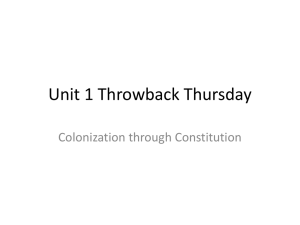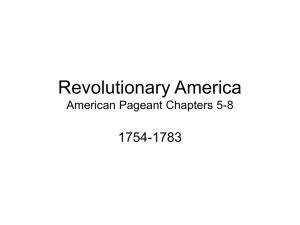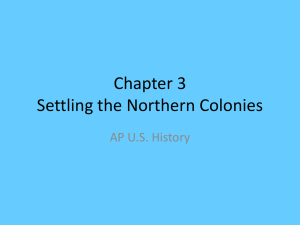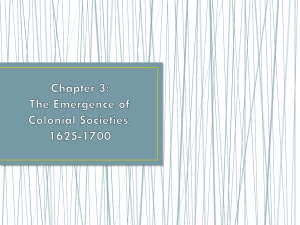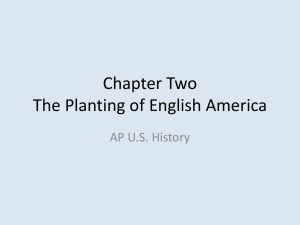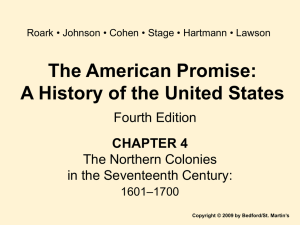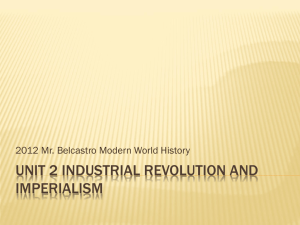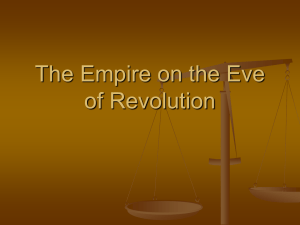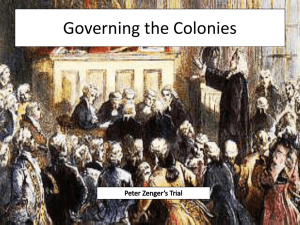File - Mr. Woznyj AP US History/IB HOTA @ North
advertisement
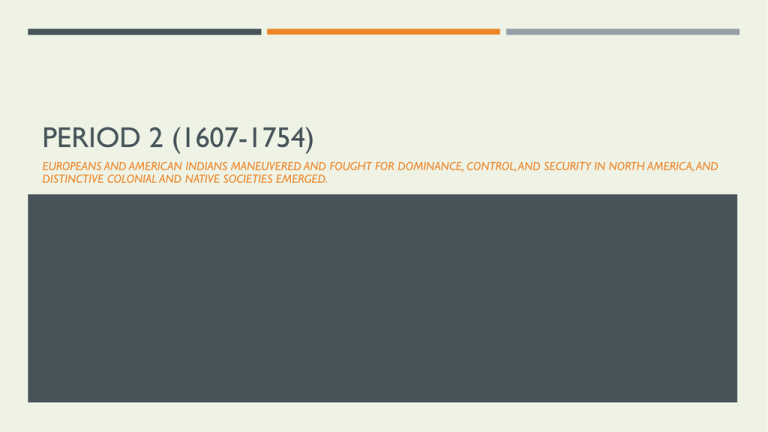
PERIOD 2 (1607-1754) EUROPEANS AND AMERICAN INDIANS MANEUVERED AND FOUGHT FOR DOMINANCE, CONTROL, AND SECURITY IN NORTH AMERICA, AND DISTINCTIVE COLONIAL AND NATIVE SOCIETIES EMERGED. REVIEW OF PERIOD 1 GROUP QUIZZES Multiple choice questions Always answer every multiple choice question (no penalty for it!) Use process of elimination (eliminate no answer choices = 25% chance of correct answer, eliminate one answer choice = 33% chance of correct, etc.) Stimulus-based questions always refer back to the “source”—can be greatly benefited by knowledge on subject matter REVIEW OF PERIOD 1 GROUP QUIZZES Political Economic Always write in full sentences (outlines will not even be given consideration Be concise and to the point but not overly generalized (i.e. technology, disease, etc.) Include two to three major points that are supportive of your “answer” Think about P.E.R.S.I.A P.E.R.S.I.A. Short-answer questions Religious Social Intellectual Artistic ANSWERS WOULD IDEALLY INCLUDE… 18. What factors made Native American peoples vulnerable to conquest by European adventurers in the sixteenth century? Lack of Political Unity Technology Lack of Immunity to European Diseases 19. What factors led to the development of the transatlantic trade in African slaves in the 1600s? European Factors African Factors REVIEW OF PERIOD 1 GROUP QUIZZES Long-Essay Questions Quick outline! = purposefulness and organization Thesis statement included that answers all parts of the question Specific evidence used clearly and consistently and states how the evidence supports the thesis or argument Clear linkages established between the evidence and the thesis or argument ANSWERS WOULD IDEALLY INCLUDE… A. By the early 1500s, Europe had become a major international influence, and its incursions into Africa and the Americas had set world history on a new course. How did Europe’s activity in Africa and North America in the sixteenth century affect each of the three continents? Who were the beneficiaries and who were the victims of Europe’s activities? Answer would ideally include: Europe: Europe’s involvements in Africa and North America benefited Europe greatly. In Africa, it gained access to new commodities and markets that brought not only greater commercial development and cultural flowering, but great wealth and power for some. Europeans did not make inroads into Africa, but they carried out gold, slaves, and various profitable products. In the Americas, they eventually gained the riches of the Aztec and Inca empires, massive quantities of land that would soon produce profitable staple crops, and a new market for slaves. European incursions into Africa and the Americas helped to transform Europe from a political and cultural backwater to a dominant world power. Africa: Europe’s advancement into Africa in the fifteenth and sixteenth centuries probably altered Europe more than it did Africa in that period. Africans welcomed European traders because they brought a variety of goods that had not been available previously. To obtain such goods, African slave traders participated willingly and enthusiastically in human trafficking with Europeans. Africa helped to build Europe’s wealth and power. African slaves who were forcibly removed to European colonies were victimized by the process. North America: Europe’s incursions into North America benefited Europe and caused a great deal of harm to the region’s native people and empires. Europe gained tremendously, while native people suffered terribly from death, disease, religious conversion efforts, enslavement, and property loss. Aztec, Inca, and North American societies that had existed before Europeans’ arrival would never be the same. ANSWERS WOULD IDEALLY INCLUDE… B. What were the major social and environmental developments that made America a new world for both Europeans and Indians? Answer would ideally include: Disease: Outbreaks of European diseases, such as smallpox, measles, and influenza, diminished the Indian population and the ability of Indians to resist territorial takeover. At the same time, Europeans in the Chesapeake regions were exposed to mosquito-borne illnesses that were new for them and killed large numbers of settlers. Christianity: The influence of Christian churches made the Americas different for Native Americans. Europeans’ efforts to convert Indians to Catholicism in New France and New Spain provided important justifications for their exploitation.Yet Indians also transformed Christianity by infusing it with some of their own beliefs and traditions. Uniquely American forms of Christianity were different for both Native Americans and Europeans. Environment: Europeans confronted an environment that was totally new for them. Many of its plants and animals and all people were different from those of Europe. They adapted to new forms of food, such as maize, squash, and potatoes. For those Europeans who settled in tropical and subtropical regions, the climate was entirely new and they adapted plantation agriculture to create their economic foundation. Indians also experienced new European dietary customs. The European fur trade decreased the populations of many furbearing animals in North America. Simultaneously, Europeans introduced new species, such as horses, to the Americas and altered elements of Native Americans’ lives. Technology: Europeans brought new inventions, including metal tools and pots, the wheel, and guns and gunpowder, to the Americas. The fur trade brought some of these new goods to Indian communities, fostering their dependence on European technology. Slavery: The institution of slavery was new for many Europeans and Native Americans. In South America and Central America, the old tribute system was adapted to provide coerced labor for the Spanish. In the Chesapeake, black slavery was introduced to the English, who had not made use of it in England. Its introduction in North America created a new form of society for Native Americans, English settlers, and African slaves. ONLINE SUPPORT: LEARNING CURVE Students were asked, what they like about Learning Curve… Here are some of their answers! INTRODUCTION TO THE SALEM WITCH TRIALS In the warm summer months of 1692, twenty women and men were put to death in Salem, Massachusetts, for practicing witchcraft. Why this happened has been the subject of historical debate for many years. Witchcraft hangings of this scale had never happened before in America and have never happened since. WHAT CAUSED THE SALEM WITCH TRIALS OF 1692? This document based exercise asks you for your educated opinion as to why they occurred 1. Read through the background essay 2. Read and analyze Documents 1 – 9 3. Complete the “Scaffolding Questions Unit I” 4. Using the “Chickenfoot” method, create a thesis statement 5. Complete the DBQ Outline Essay Guide **For extra credit, you may write up the essay WARM-UP—PLEASE TURN IN YOUR DBQ ESSAY OUTLINE GUIDE 1. On the “surface”, what do you see in painting? 2. What does the painting imply about the American colonial system? 3. Whose point of view is represented in the painting? P.E.R.S.I.A. NOTES ON “THE NEW WORLD” P.E.R.S.I.A. Political Economic Religious Social Intellectual Artistic POLITICAL CONTROL(LERS) IN THE NEW WORLD Administration and government of the British colonies ≈ expression of those of the motherlands COLONIAL GOVERNMENT: GOVERNORS MA, NH, NY, NJ, VA, NC, SC, GA Governor appointed by the British King MD, PA, DE Proprietary colonies— governor appointed by the proprietor CT, RI Corporate colonies— governors were elected POLITICAL CONTROL(LERS) IN THE NEW WORLD: ENGLISH Represents an extension of the English Parliament Based on common law POLITICAL CONTROL(LERS) IN THE NEW WORLD: ENGLISH English colonies had the power of self-government Representative assemblies voted in by popular support COLONIAL GOVERNMENT: COLONIAL ASSEMBLIES Upper houses (or councils) Appointed by the governor Lower Houses Elected by population At least 50 % of American white adult males could vote (compared with only 15 % in Britain) COLONIAL GOVERNMENT: BRITISH RULE Charters were the umbilical cords attaching the colonies to Britain—the “mother country” Tied the colonies to the Crown rather than to Parliament ROLE OF RELIGION IN THE NEW WORLD Americas were colonized by Europeans who wanted to extend the influence of Christianity Spanish America dominated by the Roman Catholic Church British colonies were mostly Protestant ROLE OF RELIGION IN THE NEW WORLD: ENGLISH Plurality of faith was the norm What people believed depended on where they lived COLONIAL SOCIETY Elites—great landowners and wealthy landowners Professionals—ministers, lawyers, doctors, schoolmasters, etc. Property holders Laborers—apprentices, sailors, servants, etc. Black slaves COLONIAL ECONOMY Prescribed to theories of mercantilism and economic self-sufficiency ECONOMIC SYSTEMS OF THE NEW WORLD Colonial economy directly tied to mercantilism ECONOMIC SYSTEMS OF THE NEW WORLD: ENGLISH British begin passing regulatory laws to benefit their own economy Colonies not allowed to compete with Britain in manufacturing Navigation Acts—protectionist laws ECONOMIC SYSTEMS OF THE NEW WORLD: ENGLISH Many colonists defied the restrictions of the Navigation Acts and British government was often lax in enforcement Leads to salutary neglect SOCIAL SYSTEMS OF THE NEW WORLD: PUSH / PULL FACTORS SOCIAL SYSTEMS OF THE NEW WORLD: ENGLISH Usually came in family groups or even as whole communities Social structure largely based on (economic) class POPULATION Between 1700 and 1763 the 13 colonies’ population increased from 250,000 to 2 million A high birth rate A low death rate Immigration and the slave trade COLONIAL MELTING POT 17th Century settlers were of English stock Some 400,000 people migrated to the 13 colonies between 1700 and 1763 Less than a fifth of the 18th century migrants were English AMERICAN CULTURE Education religion Strongly encouraged in Majority of Americans were the colonies Protestants ¾ of white male adults Immigration coupled with religious were literate Influenced by the Enlightenment toleration multiplicity of denominations Great Awakening emphasis on the individual’s personal relationship with God THE QUAKERS, THE DUTCH AND THE WOMEN If someone says it better, let them say it… Crash Course: US History While watching, make comparisons with your taken notes and jot down any new information! 4-3-2-1 READING STRATEGY For homework, using Chapter 2 of The People’s History of the United States [ONLINE]… 4 – Write down four important topics touched upon in the reading 3 – Write three possible AP-type questions that could come from these topics 2 – Write two questions that you need to have clarified in class 1 – What was the MAIN IDEA that was stressed in the reading? (2 sentences minimum) WARM-UP: PRIMARY SOURCE ANALYSIS: THE AFRICAN SLAVE TRADE The Blue Laws of Connecticut (1672) Read (pg. 53) and answer the following questions… 1. How did the punishment fit the crime? 2. Which offenses would still be regarded as criminal punishment? INTERCONNECTION BETWEEN OF RELIGION, GOVERNMENT AND SOCIETY The Blue Laws of Connecticut (1672) 10. If any man steals a man or mankind and sells him, or if he be found in his hand, he or she shall be put to death (Deuteronomy 19.16, 18, 19.)… Does this make slavery unjustifiable? THE ATLANTIC SLAVE TRADE If someone says it better, let them say it… The Atlantic Slave Trade: Crash Course World History #24 While watching, complete the fill-in notes! WHY: AFRICAN AMERICANS IN THE COLONIES Need for cheap labor, especially in southern colonies Why not? 1. European immigrants 2. Native Americans 3. Indentured servants INTRODUCTION OF AFRICAN AMERICANS IN THE COLONIES First Africans arrive in Virginia, 1619 Initially treated as indentured servants As numbers increase whites worry about control (e.g., Carolina) GROWTH OF AFRICAN SLAVE TRADE Breakup of Royal African Company's monopoly stimulates slave trade Slaves easy to obtain/prices reasonable Profits from slave trade high Slave trade fits into established trade patterns INSTITUTIONALIZING OF AMERICAN SLAVERY Factors favoring Southern planters gain a self-renewing labor force In areas with large African population, control easier Escape difficult Belief: Africans are inferior to Caucasians Lack of opposition (Cotton Mather, "What God will have to be the thing appointed for you.") SLAVERY AS A POPULATION By 1750, slavery legal in all colonies Slave population in all colonies By 1775, 80 percent of slaves in colonies American born Very few free blacks until after revolution SLAVERY AND MORALITY Great Awakening stimulates Christianizing of slaves Harsh treatment of 17th century; softens somewhat during the 18th Enlightenment causes some to rethink the legitimacy of slavery WHAT IS AT THE ROOT OF SLAVERY? RACE, RELIGION, OR PROFIT? PRIMARY SOURCE ANALYSIS: THE AFRICAN SLAVE TRADE The Stono River Rebellion in South Carolina (1739) Read (pgs. 79 - 81) and answer the following questions… 1. What did their behavior suggest about the character of colonial slavery? 2. What appear to be the greatest fears of the white slave-owning minority? WARM-UP: USING SUPPORTING EVIDENCE The Claim… Sitting in the sun ruins your skin The temperature of the earth is getting warmer Cracking your knuckles causes arthritis Eating spinach makes you strong True or False? Why do you think that? Where does your thought come from? WHEN IS THANKSGIVING? COLONIZING AMERICA If someone says it better, let them say it… When is Thanksgiving? Colonizing America: Crash Course US History #2 While watching, complete the fill-in notes! PATTERNS OF COLONIAL SETTLEMENT: NEW ENGLAND Plymouth Colony, 1620 Massachusetts Bay Colony, 1630 Separatists Puritans Mayflower Compact John Winthrop's "city upon a hill" PATTERNS OF COLONIAL SETTLEMENT: NEW ENGLAND Dissenters from Puritan theology establish new colonies Roger Williams establishes colony in Rhode Island Anne Hutchinson (with Williams’ support) establishes Portsmouth community in RI PATTERNS OF COLONIAL DEVELOPMENT: MIDDLE COLONIES New York/New Jersey/Delaware,1664 Taken from Dutch Agriculture dominant occupation Pennsylvania, 1681 Proprietary colony (land grant to William Penn) Haven for Quakers PATTERNS OF COLONIAL SETTLEMENT: THE CHESAPEAKE & “THE SOUTH” REGION Jamestown, 1607 London Company/economic gain Salvation from tobacco Anglican Church Maryland, 1632 Proprietary colony (land grant to Lord Baltimore -- expectation of profit by proprietor) Haven for Roman Catholics PATTERN OF COLONIAL DEVELOPMENT: THE CHESAPEAKE & “THE SOUTH” REGION Restoration colonies (Carolinas), 1665 Proprietary colonies established by Charles II Anglican Church Georgia, 1732 Envisioned as a haven for debtors System of smallholdings COLONIAL AREA RESEARCH Name of colony or colony group Date(s) settled 1. Read primary source and supplemental overview 2. Identify the following information about their colony group Reason(s) settled Geographic features Climate Major cash crops Ethnic makeup of colonists Religious influences Role and views of slavery How the colony was governed CLASS REVIEW New England Colonies Middle Colonies Chesapeake / Southern Colonies Name of colony or colony group Date(s) settled Reason(s) settled Geographic features Climate Major cash crops Ethnic makeup of colonists Religious influences Role and views of slavery How the colony was governed Name of colony or colony group Date(s) settled Reason(s) settled Geographic features Climate Major cash crops Ethnic makeup of colonists Religious influences Role and views of slavery How the colony was governed Name of colony or colony group Date(s) settled Reason(s) settled Geographic features Climate Major cash crops Ethnic makeup of colonists Religious influences Role and views of slavery How the colony was governed ANALYTICAL ESSAY Which colonial area was the most essential to the development of the United States? Arguments should be structured with economic, political, religious, and geographic factors in mind. Arguments must be backed up with convincing evidence.
